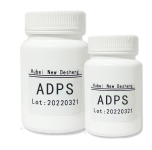Chinese VersionChina Suppliers > Hubei new DE sheng material science and technology co., LTD. > How does ADPS, a chromogenic substrate, develop color?
- Search Product
-
-
- Region :China/Hubei
- Tel : +86-18971041571
- Fax :
- Email :vickyzhao@whdschem.com
- URL :
- Add :Guanggu United Science and Technology City C8, Ezhou City, Hubei Province
- Details for How does ADPS, a chromogenic substrate, develop color?
-
How does ADPS, a chromogenic substrate, develop color?
Category : Other Chemicals/Others

CAS NO : 82611-88-9 EC NO : MF : C12H18NNaO4S MW : 295.3304 Specification : White Powder Packing : 500g/bottle Product description : ADPS (N-ethyl-N - (3-sulfopropyl) -3-methoxyaniline sodium salt dihydrate), as a novel Trinder's reagent, plays an important role in biochemical analysis and detection. It is often used as a chromogenic substrate for horseradish peroxidase (HRP) or peroxidase (POD) to determine the content of various biomolecules. How does it develop color as a chromogenic substrate? Let's take a look together. The colorimetric mechanism of ADPS substrates is based on the principle of enzyme catalyzed reactions. Under the catalytic action of HRP or POD, hydrogen peroxide (H2O2) participates in the coupled oxidation reaction of substrate ADPS. The reaction product of ADPS is a quinone imine substance, with a significant increase in absorbance at 500nm. This characteristic makes ADPS a high-quality chromogenic substrate, suitable for the determination of many enzyme catalyzed reactions. Taking the detection of glucose (Glu) as an example: In the detection of Glu, glucose is oxidized by glucose oxidase (GOD) to produce gluconic acid and hydrogen peroxide (H2O2), which are key substances in the reaction. In this step, H2O2 acts as a catalyst for the chromogenic substrate ADPS. The coupled oxidation reaction between ADPS and hydrogen peroxide can lead to a significant increase in absorbance at 500nm, which is directly proportional to the content of the detected biomolecules. Therefore, in blood glucose detection, by measuring changes in absorbance, we can determine the glucose content in the blood. This analytical method is extremely sensitive and accurate, and has been widely applied in fields such as medical diagnosis and biological research. In addition, the high water solubility of ADPS substrates is also an advantage of its application. It can be mixed with other reagents and is suitable for different types of experimental reagent systems. At the same time, its chemical properties make it stable in different reaction systems, ensuring the reliability of experimental results. From the above, it can be seen that the colorimetric principle of the chromogen substrate ADPS is based on enzyme catalyzed reactions, using the quinone imine substances produced by its coupled oxidation reaction with hydrogen peroxide to determine the content of the detected substance. In various biological analyses, such as blood glucose detection, ADPS makes the test faster and more sensitive, while precise analysis ensures the accuracy of the results. As a production supplier of chromogen substrates, Desheng can provide raw materials and reagents with good water solubility and high purity, and has a complete range of product types, including more than ten types such as MAOS, TOOS, DA64, DA67, etc., for customers to choose from at a discounted price. If you have any relevant intentions, you can click on the website to inquire about our purchase at any time! Uses : The New trinder's reagent Synonyms : ADPS;sodium 3-[ethyl(3-methoxyphenyl)amino]propane-1-sulfonate;N-Ethyl-N-(3-sulfopropyl)-3-methoxyaniline sodium salt;ADPS(ESPAS); Molecular Structure : 
- more>>Other Products
-
- • Biological buffer 3- [N, N-di (hydroxyethyl) amino] -2-hydroxypropanesulfonic acid DIPSO
- • Luminol Sodium Salt
- • 4-Aminophthalhydrazide
- • acridinium ester DMAE-NHS
- • acridinium ester NSP-DMAE-NHS
- • Acridine hydrochloride NSP-SA
- • Acridine hydrochloride NSP-SA-NHS
- • NSP-SA-ADH
- • acridinium ester ME-DMAE-NHS TOOS; 3-(N-Ethyl-3-Methylanilino)-2-Hydroxypropanesulfonic Acid Sodium Salt
- • TOPS; Sodium 3-(N-Ethyl-3-Methylanilino)Propanesulfonate; N-Ethyl-N-Sulfopropyl-M-Toluidine Sodium Salt
- • ADOS Sodium 3-(Ethyl(3-Methoxyphenyl)Amino)-2-Hydroxypropane-1-Sulfonate Dihydrate
- • ADPS N-Ethyl-N-(3-Sulfopropyl)-3-Methoxyaniline Sodium Salt
- • ALPS N-Ethyl-N-(3-Sulfopropyl)Aniline Sodium Salt; Sodium 3-(Ethyl(Phenyl)Amino)Propane-1-Sulfonate; Sodium
- • DAOS; Sodium 3-((3,5-Dimethoxyphenyl)(Ethyl)Amino)-2-Hydroxypropane-1-Sulfonate
- • HDAOS; N-(2-Hydroxy-3-Sulfopropyl)-3,5-Dimethoxyaniline Sodium Salt
- • MADB N,N-Bis(4-Sulfobutyl)-3,5-Dimethylaniline Disodium Salt
- • MAOS N-Ethyl-N-(2-Hydroxy-3-Sulfopropyl)-3,5-Dimethylaniline Sodium Salt Monohydrate
- • DAB 3,3',4,4'-Biphenyltetramine Tetrahydrochloride